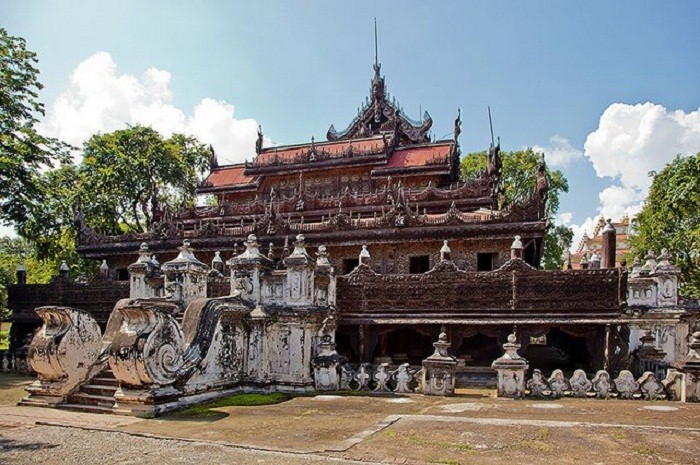Shwenandaw monastery is a great example of the 19th century constructions with teak architecture. It is also an important masterpiece of complicated wood carving from mythical Buddhist mythology. Many Myanmar travel reviews give tourists advice for a trip to this lovely destination. The historic monastery of Maha Aung Mye, Dawna of Mandalay, is located near the foothills of Mandalay. It was built in the 19th century under the reign of King Mindon. It was known as the Royal Monastery. Shwenandaw is well-known both inside and outside the country as a typical model of traditional architecture and unique carved art on teak wood of the temples and country. Noted in Burma travel books, 40 kilometers from Mandalay Center, Shwenandaw Teak Wooden Monastery is a popular Myanmar tourist destination thanks to its ancient architecture, fine carvings and the peaceful and quiet beauty.

Mandalay is the second largest economic city in Myanmar after Yangon. And this beautiful city also becomes a travel highlight Myanmar to many people by the nostalgic beauty of the former capital in Burma. King Mindon, who owned the last dynasty of the monarchy in Myanmar, decided to choose Mandalay as the capital and build a prosperous city that began in 1857.
The king is respected and beloved by myanmar people. He is known as a genius in architecture and sculpture. So during the reigning years, from 1853 to 1878, he devoted himself to setting up the capital of Mandalay into a splendid city, the bold royal palace of tradition and sophistication, along with the temple has the most special architecture ever before. And Shwenandaw Monastery is an important piece of the Myanmar imperial architecture. It was built entirely of teak from 1857 to 1859. Reflected in Myanmar travel reviews, this is one of the best architectural achievements of the Mindon Dynasty.

Shwenandaw is a part of Amarapura palace. Then it was taken to Mandalay with the name Mya Nan San Kyaw. This Myanmar top attraction was becoming the Northern part of the glass palace and part of the royal palace of King Mindon and the Queen.
After King Mindon died in this building, the successor of King Thibaw (1878-1885) often came here to meditate. But it seems that the teak house was obsessed with the soul of King Mindon. Therefore, in October 1848, King Thibaw moved the palace, nơ known á a famous Myanmar tourist site, closed to Atumashi Monastery in the East corner and the North of the imperial capital.
In the following five years, the bungalow was re-created as a monastery and a memorial to King Mindon’s merit. Today, Shwenandaw is describes in some Myanmar travel reviews the only remaining original wooden architecture of the Royal Mandalay Palace.

The building is a large multi-storey bungalow of Burma highlights with four separate, majestic and splendid roofs. All over the walls of the house, the roof, the corridor and the parapet are intricately carved, sophisticated with pictures with Buddhist myths, birds and flowers. The second layer in the middle is Saung Zay Ta Wun palace.

The monastery floor is located on teak pillars consisting of 15 pillars in the Northeast and 10 in the south-west direction. All 150 pillars are placed in a stylized lotus, 54 “Nayar” (one form Mythical creatures) decorate the external columns of the building. That was noted in Myanmar trip blogs to show the majesty and the sense of protecting the monastery from being attacked by the evil forces.

Carvings on the corridors, exterior railings and other wooden items are highly valued art as well as flair, reminiscent of a glorious era of old royal palace. Decorative lines on the roof look like a flame image created from elaborate carvings of many creatures and poultry. It is a feature of Myanmar attractions emphasized in the roof corners.

Today, Shwenandaw is a monastery, but no monks actually live in this beautiful building. This place has become a popular attraction for tourists and photographers worldwide to come and visit with the guide from Myanmar travel reviews.

